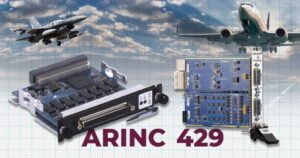In the world of aviation, communication is paramount. ARINC 429, a widely used standard, plays a crucial role in facilitating data exchange between avionics systems.
Understanding its key features, standards, and data types is essential for anyone involved in aviation technology.
In this blog, we’ll dive into the basics of ARINC 429, shedding light on its significance and demystifying its complexities.
Whether you’re a seasoned professional or just starting to explore aviation communication, this introduction will set the stage for a deeper understanding of ARINC 429 and its impact on modern aviation.

Key Features of ARINC-429
Data Frame Structure: The “Data Frame Structure,” a crucial part of ARINC-429, outlines the organization and transmission of data over a communication network.
This structure establishes the format of the data frame and describes the presentation and packaging of the data for reliable transmission between avionic devices.
The following provides more information on each of the ARINC-429 Data Frame Structure’s elements:
- Label:
The label, which serves as an important identifier to inform the recipient system of the type of data being received, is a fundamental component of the data frame. It typically consists of 8 bits and comprises information about altitude, airspeed, and other metrics linked to the system. Interoperability and homogeneity across different avionic systems are ensured via standardized labels.
- Data Field:
The data column contains the actual data that is being delivered. This segment carries the numerical or status information relevant to the assigned label; its size varies but typically takes up 19 bits. The data format can be binary, BCD (Binary-Coded Decimal), or another representation, depending on the application.
- Parity Bit:
By providing a means of error detection, the parity bit serves to enhance data integrity. One bit is set to ensure that the total number of bits in the data frame is odd or even. This parity check allows the receiving system to identify and alert it to any transmission errors.
ARINC 429 Standards
The ARINC 429 specifications are also known as the Mark 33 Digital Information Transfer System (DITS) bus. Although they are also used in ground vehicles, weapons systems, and other commercial and military equipment industries, these buses are primarily used in the avionics business.
The standards provide the word structure, electrical component properties, and protocol needed for effective communication. The Mark 33 DITS bus, a Simplex twisted shielded pair data bus, is the standard bus used by ARINC 429. The hardware and data formats needed for bus transmission are specified by ARINC.
A single connected transmitter or source is made up of hardware connected to one to twenty sinks or receivers on a single twisted wire pair. Unidirectional connections can only transport data in one direction, hence bi-directional communication needs two channels, or buses.
Physical Layer and Electrical Characteristics of ARINC 429
The bipolar return-to-zero (BRZ) differential voltage encoding method is used by ARINC-429. This encoding technique helps with noise reduction and enables long-distance data exchange. As the voltage between the two wires—a high voltage (HI) and a low voltage—changes, data is sent in accordance with protocol requirements (LO).
The physical layer of the ARINC-429 protocol describes the electrical characteristics needed for devices to properly communicate with one another. It provides time requirements, voltage levels, and impedance matching information.
The differential voltage between the HI and LO wires serves as a representation of the data; a voltage difference of 2.5 volts denotes a binary 1, and a voltage difference of -2.5 volts denotes a binary 0.
The protocol puts restrictions on minimum resistance, maximum capacitance, and wire lengths to guarantee appropriate electrical characteristics.
Adherence to these guidelines guarantees dependable data transmission and reduces the possibility of signal deterioration or disruption.
Data Types specified in ARINC 429:
Binary Coded Decimal (BCD):
The advantage of employing the binary decimal technique is that, similar to hexadecimal, each decimal digit is represented by a group of four binary digits or bits.
For 10 decimal digits, we therefore need a four-bit binary code (0-to-9). The BCD format uses four bits of the data field to display each decimal digit.
Five binary values can be generated from up to five sub-fields; the most significant sub-field can only contain three data field bits.
Bits 27–29 are padded with zeros to represent 4 binary values instead of 5 if the Most Significant Digit is greater than 7 and the second sub-field becomes the Most Significant Digit. The SSM field indicates the sign of the data.
Binary Number Representation (BNR):
The fractional complement of the two binary variables. Binary numbers are used in BNR coding to store data. The data’s sign is indicated by bit 29, and a 1 denotes a negative value. Bit 28 provides the data’s MSB.
Discrete Data:
It may consist of ISO #5 bits, BNR bits, or BCD bits combined. Pass/Fail, Activated/Non-Activated and True/False conditions about device or subsystem operational activity can be expressed by setting or clearing preset bits in the word data field.
Maintenance Data / Acknowledge:
Two-way or duplex communication between the source and sink is required for maintenance details and acknowledgment. Because only single-way simplex transmission is supported by ARINC 429, two ARINC channels are needed for the LRU to send and receive data.
A bit-oriented protocol, like the Williamsburg/Buckhorn protocol, is usually used for maintenance messages, which frequently entail exchanging many messages.
Williamsburg/Buckhorn Protocol:
File transfers occur using a bit-oriented protocol on the ARINC Data bus. If we need to transport data that is longer than 21 bits, the file transfer protocol becomes vital and important.
Source and sink units must first create a handshake in order to select a common protocol that can be used by both the transmitter and the receiver before beginning a file transfer with the bit-oriented protocol.
The word count and destination code are sent in a Word Send Request (RTS). In order to ensure accuracy, the receiver responds with a Clear to Send word (CTS), retransmitting the word count and destination.
Once it has been determined that the CTS files have been received, the source begins file transfer.
Conclusion
As we conclude our exploration of ARINC 429, it’s evident that this standard stands as a cornerstone in aviation communication. Its robust features, adherence to stringent standards, and diverse data types ensure efficient data exchange within aircraft systems. By understanding ARINC 429’s word formats and data structures, aviation professionals can enhance system interoperability, safety, and reliability. As technology advances, ARINC 429 continues to evolve, remaining a vital component in the ever-changing landscape of aviation. Embracing and mastering ARINC 429 is not just a necessity but a pathway to unlocking new possibilities in aviation communication.






